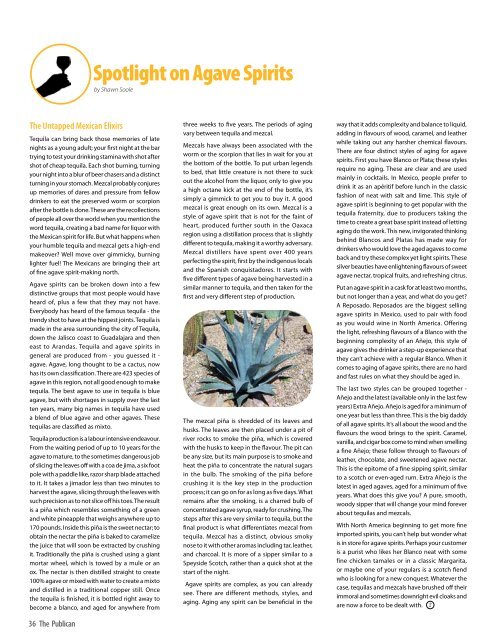The Spike Pub & Liquor Store - ABLE BC
The Spike Pub & Liquor Store - ABLE BC
The Spike Pub & Liquor Store - ABLE BC
Create successful ePaper yourself
Turn your PDF publications into a flip-book with our unique Google optimized e-Paper software.
Spotlight on Agave Spirits<br />
by Shawn Soole<br />
<strong>The</strong> Untapped Mexican Elixirs<br />
Tequila can bring back those memories of late<br />
nights as a young adult; your first night at the bar<br />
trying to test your drinking stamina with shot after<br />
shot of cheap tequila. Each shot burning, turning<br />
your night into a blur of beer chasers and a distinct<br />
turning in your stomach. Mezcal probably conjures<br />
up memories of dares and pressure from fellow<br />
drinkers to eat the preserved worm or scorpion<br />
after the bottle is done. <strong>The</strong>se are the recollections<br />
of people all over the world when you mention the<br />
word tequila, creating a bad name for liquor with<br />
the Mexican spirit for life. But what happens when<br />
your humble tequila and mezcal gets a high-end<br />
makeover Well move over gimmicky, burning<br />
lighter fuel! <strong>The</strong> Mexicans are bringing their art<br />
of fine agave spirit-making north.<br />
Agave spirits can be broken down into a few<br />
distinctive groups that most people would have<br />
heard of, plus a few that they may not have.<br />
Everybody has heard of the famous tequila - the<br />
trendy shot to have at the hippest joints. Tequila is<br />
made in the area surrounding the city of Tequila,<br />
down the Jalisco coast to Guadalajara and then<br />
east to Arandas. Tequila and agave spirits in<br />
general are produced from - you guessed it -<br />
agave. Agave, long thought to be a cactus, now<br />
has its own classification. <strong>The</strong>re are 423 species of<br />
agave in this region, not all good enough to make<br />
tequila. <strong>The</strong> best agave to use in tequila is blue<br />
agave, but with shortages in supply over the last<br />
ten years, many big names in tequila have used<br />
a blend of blue agave and other agaves. <strong>The</strong>se<br />
tequilas are classified as mixto.<br />
Tequila production is a labour intensive endeavour.<br />
From the waiting period of up to 10 years for the<br />
agave to mature, to the sometimes dangerous job<br />
of slicing the leaves off with a coa de jima, a six foot<br />
pole with a paddle like, razor sharp blade attached<br />
to it. It takes a jimador less than two minutes to<br />
harvest the agave, slicing through the leaves with<br />
such precision as to not slice off his toes. <strong>The</strong> result<br />
is a piña which resembles something of a green<br />
and white pineapple that weighs anywhere up to<br />
170 pounds. Inside this piña is the sweet nectar; to<br />
obtain the nectar the piña is baked to caramelize<br />
the juice that will soon be extracted by crushing<br />
it. Traditionally the piña is crushed using a giant<br />
mortar wheel, which is towed by a mule or an<br />
ox. <strong>The</strong> nectar is then distilled straight to create<br />
100% agave or mixed with water to create a mixto<br />
and distilled in a traditional copper still. Once<br />
the tequila is finished, it is bottled right away to<br />
become a blanco, and aged for anywhere from<br />
36 <strong>The</strong> <strong>Pub</strong>lican<br />
three weeks to five years. <strong>The</strong> periods of aging<br />
vary between tequila and mezcal.<br />
Mezcals have always been associated with the<br />
worm or the scorpion that lies in wait for you at<br />
the bottom of the bottle. To put urban legends<br />
to bed, that little creature is not there to suck<br />
out the alcohol from the liquor, only to give you<br />
a high octane kick at the end of the bottle, it’s<br />
simply a gimmick to get you to buy it. A good<br />
mezcal is great enough on its own. Mezcal is a<br />
style of agave spirit that is not for the faint of<br />
heart, produced further south in the Oaxaca<br />
region using a distillation process that is slightly<br />
different to tequila, making it a worthy adversary.<br />
Mezcal distillers have spent over 400 years<br />
perfecting the spirit, first by the indigenous locals<br />
and the Spanish conquistadores. It starts with<br />
five different types of agave being harvested in a<br />
similar manner to tequila, and then taken for the<br />
first and very different step of production.<br />
<strong>The</strong> mezcal piña is shredded of its leaves and<br />
husks. <strong>The</strong> leaves are then placed under a pit of<br />
river rocks to smoke the piña, which is covered<br />
with the husks to keep in the flavour. <strong>The</strong> pit can<br />
be any size, but its main purpose is to smoke and<br />
heat the piña to concentrate the natural sugars<br />
in the bulb. <strong>The</strong> smoking of the piña before<br />
crushing it is the key step in the production<br />
process; it can go on for as long as five days. What<br />
remains after the smoking, is a charred bulb of<br />
concentrated agave syrup, ready for crushing. <strong>The</strong><br />
steps after this are very similar to tequila, but the<br />
final product is what differentiates mezcal from<br />
tequila. Mezcal has a distinct, obvious smoky<br />
nose to it with other aromas including tar, leather,<br />
and charcoal. It is more of a sipper similar to a<br />
Speyside Scotch, rather than a quick shot at the<br />
start of the night.<br />
Agave spirits are complex, as you can already<br />
see. <strong>The</strong>re are different methods, styles, and<br />
aging. Aging any spirit can be beneficial in the<br />
way that it adds complexity and balance to liquid,<br />
adding in flavours of wood, caramel, and leather<br />
while taking out any harsher chemical flavours.<br />
<strong>The</strong>re are four distinct styles of aging for agave<br />
spirits. First you have Blanco or Plata; these styles<br />
require no aging. <strong>The</strong>se are clear and are used<br />
mainly in cocktails. In Mexico, people prefer to<br />
drink it as an apéritif before lunch in the classic<br />
fashion of neat with salt and lime. This style of<br />
agave spirit is beginning to get popular with the<br />
tequila fraternity, due to producers taking the<br />
time to create a great base spirit instead of letting<br />
aging do the work. This new, invigorated thinking<br />
behind Blancos and Platas has made way for<br />
drinkers who would love the aged agaves to come<br />
back and try these complex yet light spirits. <strong>The</strong>se<br />
silver beauties have enlightening flavours of sweet<br />
agave nectar, tropical fruits, and refreshing citrus.<br />
Put an agave spirit in a cask for at least two months,<br />
but not longer than a year, and what do you get<br />
A Reposado. Reposados are the biggest selling<br />
agave spirits in Mexico, used to pair with food<br />
as you would wine in North America. Offering<br />
the light, refreshing flavours of a Blanco with the<br />
beginning complexity of an Añejo, this style of<br />
agave gives the drinker a step-up experience that<br />
they can’t achieve with a regular Blanco. When it<br />
comes to aging of agave spirits, there are no hard<br />
and fast rules on what they should be aged in.<br />
<strong>The</strong> last two styles can be grouped together -<br />
Añejo and the latest (available only in the last few<br />
years) Extra Añejo. Añejo is aged for a minimum of<br />
one year but less than three. This is the big daddy<br />
of all agave spirits. It’s all about the wood and the<br />
flavours the wood brings to the spirit. Caramel,<br />
vanilla, and cigar box come to mind when smelling<br />
a fine Añejo; these follow through to flavours of<br />
leather, chocolate, and sweetened agave nectar.<br />
This is the epitome of a fine sipping spirit, similar<br />
to a scotch or even-aged rum. Extra Añejo is the<br />
latest in aged agaves, aged for a minimum of five<br />
years. What does this give you A pure, smooth,<br />
woody sipper that will change your mind forever<br />
about tequilas and mezcals.<br />
With North America beginning to get more fine<br />
imported spirits, you can’t help but wonder what<br />
is in store for agave spirits. Perhaps your customer<br />
is a purist who likes her Blanco neat with some<br />
fine chicken tamales or in a classic Margarita,<br />
or maybe one of your regulars is a scotch fiend<br />
who is looking for a new conquest. Whatever the<br />
case, tequilas and mezcals have brushed off their<br />
immoral and sometimes downright evil cloaks and<br />
are now a force to be dealt with.









